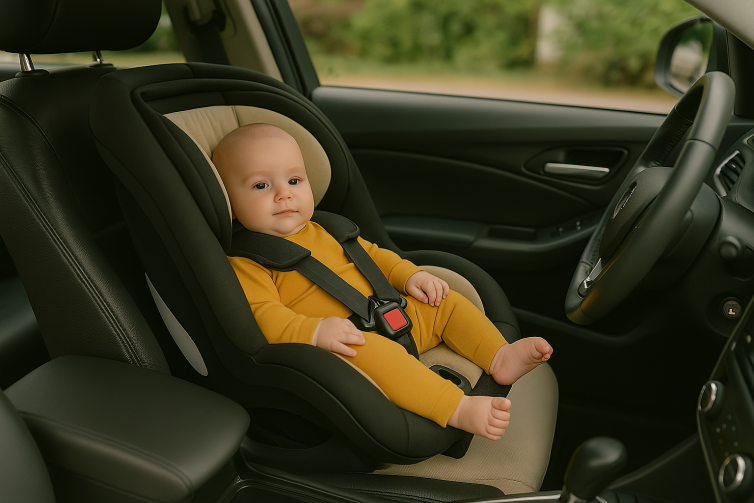The Mike Hostilo Law Firm wants to make sure that your kids are as safe as possible while riding in the car.
We understand that as your kids get older, it is sometimes difficult to remember how to correctly buckle them up. We are here to help and make sure you are prepared and have all the necessary information on how to properly buckle your kids up as they grow.
Guidelines for Choosing and Installing Car Seats Safely
Avoid These Common Car Seat Mistakes for Maximum Protection
1. Not Doing Your Homework Before Getting a Car Seat
Research is key when buying a car seat. If you’re considering a used car seat for your kid, make sure the car seat comes with instructions and a label showing the manufacturer’s date and model number. It is very important to make sure the car seat has not expired, has been recalled, and is no more than six years old.
Don’t use the car seat, if you don’t know its history.
2. Keeping Your Car Seat in the Wrong Place
Where is the best spot for your kid’s car seat? The safest place for your kid’s car seat is the back seat, away from active airbags. The car seat should also be installed in the middle of the vehicle to reduce the risk of injury in the event of an accident. If a rear-facing car seat is in the front of your vehicle, and the airbag deploys, it may strike the back of the car seat, right where the head is, injuring or killing your child upon impact. Airbags may also injure an infant in a forward-facing car seat. If your vehicle only has one row of seats, such as certain pickup trucks, make sure the airbag can be switched off with a key before placing the car seat in the vehicle.
3. Not Buckling Up Your Kid in the Right Manner
Read the manufacturer’s directions and your vehicle’s owner’s manual regarding car seats before installing any car seat in your car. Please ensure the seat is securely fastened and facing the right direction when connected at the bottom near the attachment points. There should be no more than 1 inch (2.5 centimeters) of movement from side to side or front to back. If you’re using an infant-only seat or a convertible seat in the rear-facing position, make sure to use the harness slots mentioned in the car seat’s instruction book. The brace straps should be placed at or around your kid’s shoulders.
Ensure a secure fit by buckling the belt straps and chest clip. Your kid’s armpits should be even with the chest clip. Check that the straps and clip are completely flat against the chest and over his or her hips. To provide head and neck protection, place tightly wrapped small blankets alongside your baby if possible. Also, place a rolled washcloth between the crotch strap and your baby if the car seat manufacturer requires it to provide a more comfortable fit.
4. Reclining Your Kid at the Wrong Angle
Recline the car seat in the rear-facing position per the manufacturer’s directions to prevent your kid’s head from flopping forward. To keep their airways open, babies must travel semi-reclined. To assist you, many seats have angle indicators or adjusters. Please remember, that the angle will need to be adjusted as your kid develops. For more details, consult the manufacturer’s instructions.
5. Moving to a Forward-Facing Car Seat Too Soon
Many of us want to look back and see our baby as we drive. However, avoid the temptation to put your kid’s car seat in the forward-facing spot for as long as possible. It is recommended that you use a rear-facing car seat for as long as possible or until your kid meets the car seat manufacturer’s maximum weight or height limit. It is also recommended that you start with a convertible seat that can be used backward and forward. A convertible seat has a higher rear-facing weight and height limit than an infant-only seat. Alternatively, if you do use an infant-only seat, you should transition to a convertible car seat as your kid grows.
When your kid meets the convertible seat’s weight or height limits, you may shift the seat forward. When you do so, you should:
- Install your kid’s car seat in the back seat using the seat belt or the Lower Anchors and Tethers for Children (LATCH) System, as directed by the manufacturer.
- For added stability, use the tether harness, which loops to the top of the seat and connects to the vehicle anchor.
- Adjust the harness straps to correctly fit at or above your kid’s shoulder level.
6. Not Removing Your Kid’s Heavy Outerwear
Thick and heavy outerwear and blankets will make it difficult for your kid’s harness straps to fit snugly around his or her body. To keep your baby safe, buckle the harness and then cover it with a sweater or blanket.
7. Moving to a Booster Seat Too Soon
Booster seats are required for older kids in order for an adult seat belt to fit properly. When your kid reaches the maximum weight or height permitted by the car seat manufacturer, you can transition from a car seat to a booster seat. However, keep in mind that keeping your kid in a car seat with a harness for as long as possible is the best option.
8. Using a Booster Seat Incorrectly
Booster seats should always be used with a lap and shoulder belt, not just the lap belt. Make sure that the lap belt is low over your child’s thighs and that the shoulder belt crosses your kid’s chest and shoulder in the center.
9. Transitioning to Seat Belt Before Your Kids Are Ready
Once your kids are between the ages of 8 and 12, they can comfortably use an adult seat belt. Here’s how to tell if your kid is ready:
- Your kid reaches a height of 4 feet 9 inches (nearly 1.5 meters).
- Your child can sit against the back of the seat, with their knees comfortably bent at the seat’s edge, and can stay in that position for the entire car ride.
- The lap belt is worn low over the upper thighs, not the stomach. The shoulder belt should be worn around the middle of your kid’s chest and shoulder, not around his or her neck or ears.
- Remember that kids under the age of 13 are safer in the back seat.
Consider taking part in a local car seat clinic or testing event if you have any concerns about child passenger safety laws or need assistance installing a car seat. You can also look up the closest car seat inspection station via the National Highway Traffic Safety Administration.
The Mike Hostilo Law Firm wants to make sure that your whole family is as safe as possible while traveling in the car. Remember, we are all in this together.
Trust our car accident attorneys to provide top-tier legal representation each step of the way. If you have been hurt in a car crash, our car accident attorneys are here to help – so contact Mike Hostilo Law Firm today to schedule your free consultation!
You can find us serving car crash victims in the following areas:
GEORGIA LAWYERS
(Park of Commerce) Savannah, GA
SOUTH CAROLINA LAWYERS
ALABAMA LAWYERS
More Helpful Car Accident Blogs:
3 Car Insurance Policy Add-ons You Need to Know Before a Car Accident
3 Reasons Not to Accept First Car Accident Injury Settlement Post Covid
5 Tips on What to Do After a Car Accident | Car Crash Lawyer Explains
6 Reasons Why You Should Wear Your Seat Belt | Car Crash Tips
Can Whiplash Cause a Brain Injury?
Car Seat Safety | Can You Put a Baby in The Front Seat?
Common Causes of Distracted Driving
How Can I Pay My Medical Bills After a Car Accident?
How Do I Pay for Repairs After a Car Accident?
How to File a Personal Injury Lawsuit on Behalf of Another Person
How Long Does It Take To Finalize An Auto Accident Settlement?
My Injuries After a Car Crash Were Delayed, Can I File a Claim?
The Dangers of Driving When Tired
The Importance of Wearing a Seat Belt | Auto Accidents
Risk of PTSD After a Car Accident
Texting and Driving: 9 Facts on Texting and Driving | Distracted Driving
What Are the Most Common Car Accident Injuries? | Car Crash Facts

